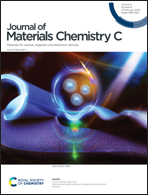Defect modification engineering on a laminar MoS2 film for optimizing thermoelectric properties†
Abstract
Two-dimensional (2D) transition-metal dichalcogenide (TMD) films have emerged as promising semiconducting materials for electronic and optoelectronic applications. However, a defect region, such as gap or void areas between the edges of the nanosheets originating from the layer-by-layer assembly of 2D nanosheets, is often inevitably present in laminar TMD films and strongly affects the semiconductor properties. In this work, we developed a defect modification strategy to patch the gap regions in molybdenum disulfide (MoS2) film for optimizing its thermoelectric performance. The defect regions can be bridged through the nanoconfinement electrostatic force between the surface anisotropic MoS2 nanosheets and inserted copper, leading to a MoS2–Cu lateral heterostructure. Compared with the MoS2 film, the carrier mobility of the modified MoS2 film increased 15 times, resulting in a high Seebeck coefficient of 159.4 μV K−1 at room temperature. In addition, the thermoelectric stability of MoS2 films can be improved simultaneously. Our results provide a new concept of microstructure regulation on laminar TMD films to improve thermoelectric performances and will promote 2D laminar films with potential applications in other semiconductor fields.



 Please wait while we load your content...
Please wait while we load your content...